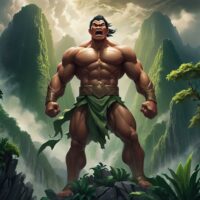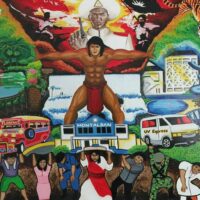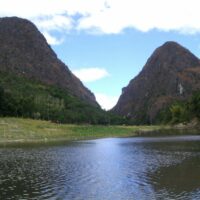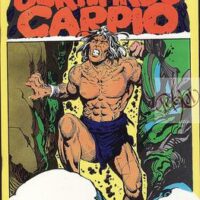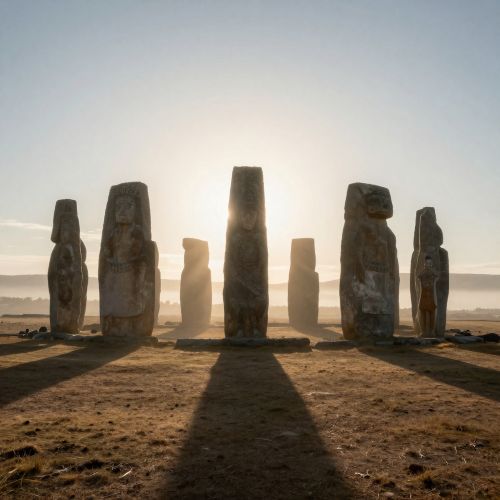Bernardo Carpio : The Mountain Stopper
Listen
At a glance
| Description | |
|---|---|
| Origin | Philippine Mythology |
| Classification | Demigods |
| Family Members | N/A |
| Region | Philippines |
| Associated With | Super Strength |
Bernardo Carpio
Introduction
Bernardo Carpio stands as one of the most iconic figures in Philippine mythology—a name whispered in mountain legends, echoed in political struggles, and admired in cultural tales. Revered as a powerful giant caught between two mountains, his myth continues to inspire Filipinos as a symbol of strength, resilience, and hope. While his story is rooted in folklore, its relevance transcends generations, often serving as an allegory for freedom and resistance against oppression.
Physical Traits
Legends describe Bernardo Carpio as a being of extraordinary size and strength. In many tales, he is portrayed as a towering giant whose mere presence commands awe. His massive frame and boundless power are symbolic—he isn’t just physically imposing but represents an unyielding force against overwhelming odds. His mythical footprints, said to be etched in the rocks of Montalban (now part of Rodriguez, Rizal), have become part of the local lore, treated with a reverence reserved for sacred relics. These physical depictions enhance the idea of a hero larger than life, both literally and figuratively.
Family
There are several variations of Bernardo Carpio’s origin story. Some accounts describe him as the child of Don Carpio, a nobleman, and a mysterious, enchanted woman—possibly a diwata or spirit of the forest. Others root him in an older world, suggesting he is the last descendant of a race of giants who once roamed the Philippines before the coming of colonizers. Unlike typical heroes whose lineage is celebrated, Bernardo’s family is shrouded in mystery. His tale emphasizes his role as a lone guardian more than his ties to any family, reinforcing his image as an enduring figure beyond time and bloodline.
Other names
The name “Bernardo Carpio” is believed to have been shaped by Spanish influence during the colonial era. Some historians suggest that the Spaniards may have borrowed the name from European literature, blending it with indigenous stories to create a hybrid myth that both reflected and suppressed local culture. While his original indigenous name may be lost to history, the character survives, carrying a Spanish name that ironically now represents Filipino resistance. In some rural communities, he’s referred to simply as “the giant of the mountains,” emphasizing his symbolic rather than literal identity.
Powers and Abilities
At the heart of the legend is Bernardo Carpio’s superhuman strength. His most iconic feat—holding apart two mountains to prevent them from crashing together—makes him a guardian of the land itself. Folklore says he was trapped in a cave between these mountains by opposing forces, either by Spanish friars, enchanted beings, or fate itself. When he struggles or tries to break free, the earth trembles. These earthquakes are interpreted as signs of his continuing fight against captivity, a metaphor for the ongoing struggle of the Filipino people against various forms of oppression.
His abilities go beyond physical might. In some versions, Bernardo is a cunning leader, a voice of reason, and a protector of the oppressed. He is not just a warrior but also a symbol of justice, deeply connected to the land and the people who live upon it.
The mountains of Montalban (particularly Mount Tapusi and Mount Pamitinan) are considered sacred sites associated with Bernardo Carpio’s legend. Locals claim these are the mountains he is trapped between, and the area has become a destination for both trekkers and believers. Cave systems in the region are often visited by those hoping to connect with his story, seeking strength and spiritual guidance. These sites have turned into cultural landmarks, blending nature, mythology, and patriotism into a single experience.
Modern Day Influence
Despite being a mythical figure, Bernardo Carpio remains firmly rooted in the Filipino consciousness. His story has been retold in books, stage plays, comic books, and even modern films. Artists use his image to portray the power of unity and the importance of cultural heritage. His legend has been invoked during political movements, especially in times of national hardship, to awaken a spirit of resistance and pride.
Some believe that when the country is truly free and its people united, Bernardo Carpio will finally be able to break free from his prison of stone. This belief keeps his story alive, especially in rural communities where oral storytelling is still vibrant. His legend is also a favorite topic in Philippine mythology education, often introduced in schools to teach children about indigenous folklore and historical struggles.
More than just a character from mythology, Bernardo Carpio has become a cultural icon who embodies the Filipino spirit. He is often viewed as a personification of the nation’s endurance, trapped between opposing forces but never giving up the fight. Scholars have interpreted his imprisonment as symbolic of the Philippines’ colonial past, while his potential freedom represents the hope for a truly independent and empowered nation.
His image is sometimes used during protest movements, not only as a representation of resistance but also as a reminder that the strength of the people lies in unity and persistence. This fusion of myth and socio-political symbolism makes Bernardo Carpio unique among mythical heroes—not only does he belong to the past, but he is also a recurring figure in contemporary struggles.
Related Images
Source
Demetrio, Francisco R. “The Myths and Legends of the Philippines.” 1991.
Jocano, F. Landa. “Philippine Mythology.” 2001.
National Commission for Culture and the Arts (NCCA). “Bernardo Carpio and Philippine Mythology.” https://ncca.gov.ph/about-culture-and-arts/culture-profile/bernardo-carpio/
Philippine Folk Literature: The Legends, Volume 1. Manila: UP Press, 1982.
Contributors to Wikimedia projects. (2007). Bernardo Carpio – Wikipedia. https://en.wikipedia.org/wiki/Bernardo_Carpio
ztevetevans. (2021). Bernardo Carpio: Legendary Strongman of the Philippines. https://ztevetevans.wordpress.com/2021/11/03/bernardo-carpio-legendary-strongman-of-the-philippines/
Frequently Asked Questions
What is lorem Ipsum?
I am text block. Click edit button to change this text. Lorem ipsum dolor sit amet, consectetur adipiscing elit. Ut elit tellus, luctus nec ullamcorper mattis, pulvinar dapibus leo.
What is lorem Ipsum?
I am text block. Click edit button to change this text. Lorem ipsum dolor sit amet, consectetur adipiscing elit. Ut elit tellus, luctus nec ullamcorper mattis, pulvinar dapibus leo.
What is lorem Ipsum?
I am text block. Click edit button to change this text. Lorem ipsum dolor sit amet, consectetur adipiscing elit. Ut elit tellus, luctus nec ullamcorper mattis, pulvinar dapibus leo.
What is lorem Ipsum?
I am text block. Click edit button to change this text. Lorem ipsum dolor sit amet, consectetur adipiscing elit. Ut elit tellus, luctus nec ullamcorper mattis, pulvinar dapibus leo.
What is lorem Ipsum?
I am text block. Click edit button to change this text. Lorem ipsum dolor sit amet, consectetur adipiscing elit. Ut elit tellus, luctus nec ullamcorper mattis, pulvinar dapibus leo.


